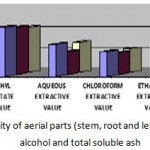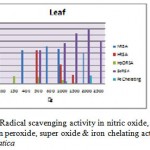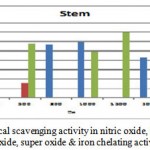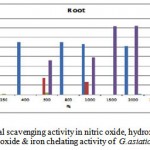How to Cite | Publication History | PlumX Article Matrix
Identification of Antioxidant Potential of Gmelina asiatica
S. Girija1* and R. Ravindhran2
1Department of Medicinal Botany, Goverment Siddha Medical College, Chennai India.
2Department of Plant Biotechnology, Loyola College, Chennai India.
ABSTRACT: Gmelina is a large straggling or scrambling deciduous bush or shrub, rather hardy, to about 3 m tall, sometimes prostrate, usually spiny, sometimes unarmed, much-branched, very variable in size and habit; bark yellowish or brownish-white, thin, smooth; wood hard, grey; branchlets horizontal, rigid, often compressed. Significant antioxidant activity were observed by Gmelina asiatica, provide a scientific validation for the traditional use of these plants. The leaf and root posses higher range of radical scavenging activity than the stem. Potential sources of antioxidants have been found in leaves, stem and roots of G. asiatica plant.
KEYWORDS: Gmelina asiatica; flavonoids; saponins; tannins; glycosides; Alkaloids
Download this article as:| Copy the following to cite this article: Girija S, Ravindhran R. Identification of Antioxidant Potential of Gmelina asiatica. Biosci Biotech Res Asia 2011;8(2) |
| Copy the following to cite this URL: Girija S, Ravindhran R. Identification of Antioxidant Potential of Gmelina asiatica. Biosci Biotech Res Asia 2011;8(2). Available from: https://www.biotech-asia.org/?p=9831 |
Introduction
Gmelina is a large straggling or scrambling deciduous bush or shrub, rather hardy, to about 3 m tall, sometimes prostrate, usually spiny, sometimes unarmed, much-branched, very variable in size and habit; bark yellowish or brownish-white, thin, smooth; wood hard, grey; branchlets horizontal, rigid, often compressed. Leaves are small. Leaf stalks 0.5-3 cm long, slender. Leaf-blades varying from oval or ovate to elliptic, obovate, subrhomboid, or triangular in outline, very variable, mostly 1-9.5 (rarely to 13) cm long, 1.5-6 cm wide, entire or 3-5 lobed when young. Flowers are large, borne in short cymules in mostly racemelike panicles 2.5-5 cm long. This plant belongs to Verbenaceae. To identify and understand the bioactive chemical components of the plant Gmelinaasiatica is the main aim of the present study.
Free radicals can cause oxidative damage to lipids, proteins and DNA, eventually leading to many chronic diseases, such as cancer, diabetes, aging, and other degenerative diseases in humans Harman. D (1998). There are several routes to tackle this problem (Perry et al., 2003; Citron, 2004), although the one that has been most successful so far is the “cholinergic hypothesis”. Natural products are important sources for biologically active drugs. SalehAlqasoumi, et.al, (2009). There has been an increasing interest in the study of medicinal plants as natural products in different parts of the world. Gazzaneo et.al,(2005). Medicinal plants containing active chemical constituents with high antioxidant property play an important role in the prevention of various degenerative diseases and have potential benefits to the society. LukmanulHakkim, F., et.al, (2008).
Natural antioxidants from plant sources are potent and safe due to their harmless nature; wild herbs have been investigated for their antioxidant properties. Lee Koon, J., et.al.,(2004). This is mainly due to their strong biological activity, excluding those of many synthetic antioxidants which have possible activity as promoters of carcinogenesis. Therefore, the need exists for safe, economic, powerful and natural antioxidants to replace these synthetic ones.
Many antioxidant compounds, naturally occurring in plant sources, have been identified as a free radical or active oxygen scavengers (Zheng& Wang, 2001).
Antioxidants may be defined as radical scavengers which protect the human body against free radicals that may cause pathological conditions such as ischemia, anaemia, asthma, arthritis, inflammation, neurodegeneration, Parkinson’s diseases, mongolism, ageing process and perhaps dementias.
Antioxidants have been detected in a number of agricultural and food products including cereals, fruits, vegetables and oil seeds. (Adom et al, 2003; Naczk and Shahidi, 2006 ;Netzel et al, 2007). Superoxide radicals (O2-), hydroxyl radical (.OH), and peroxyl radicals (ROO.), have been associated with heart disease and carcinogenesis (Steer et al 2002). Antioxidants may offer resistance against oxidative stress by scavenging the free radicals, inhibiting lipid peroxidation. So, in order to contribute further to the knowledge of Indian traditional plants, our present study is focused on measuring antioxidant activity of Gmelinaasiatica.
Material and Methods
The plants were collected, cleaned and rinsed, shade dried, powdered, weighed and stored in air tight containers until used.
Preparation of Extract
The crude extract of the plant parts were prepared in soxhlet apparatus. The plant parts (stem, root and leaves) were dried, powdered and weighed. Powdered plant parts (20g) were soaked in 200ml of organic solvent using soxhlet apparatus. Briefly the extraction was carried out at room temperature until exhaustion. The extracts were filtered and air dried at 40°C. The weight of each dry residue was recorded. The crude extract was reconstituted with Dimethyl sulphoxide (DMSO) whenever used. All extracts were prepared and stored at 4°C until used. The crude extracts of Chloroform, Ethanol, Methanol, Hexane, Ethyl acetate and aqueous were prepared. The aqueous extract was prepared using Lyophilizer.
Antioxidant assay
The antioxidant activity of the plant extracts was tested using two methods: ferricthiocyanate (FTC) and thiobarbituric acid (TBA) methods. The FTC method was used to measure the amount of peroxide at the beginning of the lipid peroxidation, in which peroxide reacts with ferrous chloride and form ferric ion. The ferric ion then combines with ammonium thiocyanate and produce ferric thiocyanate. The substance is red in colour. The thicker the colour, the higher the absorbance. Whereas the TBA methods measures free radicals present after peroxide oxidation.
Ferric thiocyanate (FTC) method-The standard method as described by (Kikuzaki and Nakatani, 1993) was used. Thiobarbituric acid (TBA) method-The method of (Ottolenghi, 1959) was referred. Antioxidant activity was based on the absorbance on the final day of FTC method.
The method of Garratt was adopted to determine the nitric oxide radical scavenging activity of aqueous extract of the plant sample. Sodium nitroprusside in aqueous solution at physiological pH spontaneously generate nitric oxide which interacts with oxygen to produce nitrite ions determined by the use of Griess reagents. The scavenging activity of superoxide anion was determined by the method of Yen and Chen.
Scavenging activity of hydrogen peroxide by the plant extract was determined by the method of Ruchet al.
 |
Figure 1: Solubility of aerial parts (stem, root and leaf) powder in acid, alcohol and total soluble ash. |
 |
Figure 2: Radical scavenging activity in nitric oxide, hydroxyl, hydrogen peroxide, super oxide & iron chelating activity of G.asiatica. |
Results and Discussion
The in vitro antioxidant assay of the plant extracts (Figure3) reveals significant antioxidant potential. The reducing power potentials of the extract Figure 4, shows the reducing power potentials of the aqueous extract of the test plant in comparison with a standard BHT (ButylatedHydroxy toluene) at 700 nm.
 |
Figure 3: Radical scavenging activity in nitric oxide, hydroxyl, hydrogen peroxide, super oxide & iron chelating activity of G.asiatica. |
 |
Figure 4: Radical scavenging activity in nitric oxide, hydroxyl, hydrogen peroxide, super oxide & iron chelating activity of G.asiatica. |
The reducing capacity of the extract, another significant indicator of antioxidant activity was also found to be appreciable. In the reducing power assay, the presence of antioxidants in the sample would result in the reduction of Fe3+ to Fe2+ by donating an electron. The amount of Fe2+ complex can then be monitored by measuring the formation of Perl’s blue at 700 nm. Increasing absorbance indicates an increase in reductive ability. The results show that there was an increase in the reactive ability.
The Nitric Oxide scavenging activity was observed from 2.0mg-20mg for all the three parts (stem, root and leaf) of the plants. Among the tested samples leaf seemed to be showing higher percentage in 8.0mg (60%), rest other two samples(stem&root) were lesser than 60% only reported in various concentrations.
The Hydroxyl Radical scavenging activity was reported to be present in leaf from 5.0mg-15mg concentration, whereas in stem and root 5.0mg and 5.0mg&10mg respectively were observed to be positive for this activity.
The H2O2 Radical scavenging activity to be present in leaf(2.5mg-20mg), in root only in lower concentration (2.5mg-1%, & 5.0mg-2%) little activity was noticed, whereas in stem there was no activity in any of the concentration. The leaf showed higher activity (11.98%) in 2.5mg and(11.54%) 5.0mg than 20mg(0.22%) and no activity in 25mg concentration.
The Super-oxide radical scavenging activity reported to be higher in leaf and root around 20mg (2000µg) were 89% and 72% respectively. In stem this activity was reported in lesser range i.e. 15mg (1500µg) about 69 %.
Discussion
Several studies have shown that plant derived antioxidant neutraceuticals scavenge free radicals and modulate oxidative stress-related degenerative effects. Antioxidants have been detected in a number of agricultural and food products including cereals, fruits, vegetables and oil seeds. (Adom et al, 2003; Naczk and Shahidi, 2006; Netzel et al, 2007). Superoxide radicals (O2-), hydroxyl radical (.OH), and peroxyl radicals (ROO.), have been associated with heart disease and carcinogenesis (Steer et al 2002). Antioxidants are increasingly being recommended because they act directly on oxidative processes and may be a method to prevent diseases ad health problems related to aging.
Significant antioxidant activity were observed by Gmelinaasiatica, provide a scientific validation for the traditional use of these plants. The leaf and root posses higher range of radical scavenging activity than the stem. Further work on isolation and identification of active compounds and its efficacy needs to be done. Phenolics are commonly found in medicinal plants and have been reported to have multiple biological effects, including antioxidant activity. Potential sources of antioxidants have been found in leaves, stem and roots of G. asiatica plant.
References
- Adom, K. K., Sorrells, M. E., & Liu, R. H., Phytochemical profiles and antioxidant activity of wheat varieties. Journal of Agricultural and Food Chemistry, 51: 7825–7834 (2003).
- E. K. Perry, A. T. Pickering, W. W. Wang, P. Houghton and N. S. Perry, “Medicinal Plants and Alzheimer’s Dis-ease: Integrating Ethonobotanical and Contemporary Scientific Evidence,” Journal of Alternative and Com-plementary Medicine, 4(4): 419-428 (1998).
- Gazzaneo, Ir., Paiva de lucena, R.F. and Paulino de Albuquerque,U.: J. Ethnobiol. Ethnomed.,1: 9 (2005)
- Harman D: Aging: phenomena and theories. Ann NY AcadSci, 854: 1-7 (1998).
- Lee Koon, J., et.al., (2004) [6] Lee Koon, J. and Min, DB.: Comp. Rev. Food. Sci. Food Safety, 3: 21-27 (2004).
- LukmanulHakkim, F., GirijaArivazhagan. And Boopathy,R.: J.Med. PlantsRes.,2(9): 250-257 (2008).(McClements& Decker, 2000).
- SalehAlqasoumi, I.,MohammadAl-Dosari, S.,AbdulMalik,Alsheikh, M. andMagedAbdel-kader, S.: Res. J.Med. Plants, 3(1): 9-15 (2009)
- Steer, P., Millgard, J., Sarabi, D. M., Wessby, B., &Kahan, T., Cardiac and vascular structure and function are related to lipid peroxidation and metabolism. Lipids, 37: 231-236 (2002).
- Zheng, W., & Wang, S.Y., Antioxidant activity and phenolic compounds in selected herbs. Journal of Agricultural and Food Chemistry, 49: 5165-5170 (2001).

This work is licensed under a Creative Commons Attribution 4.0 International License.





